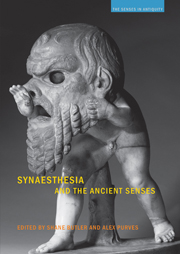Book contents
- Frontmatter
- Contents
- Contributors
- Introduction: synaesthesia and the ancient senses
- 1 Why are there nine Muses?
- 2 Haptic Herodotus
- 3 The understanding ear: synaesthesia, paraesthesia and talking animals
- 4 Aristophanes, Cratinus and the smell of comedy
- 5 “Looking mustard”: Greek popular epistemology and the meaning of δριμύς
- 6 Plato, beauty and “philosophical synaesthesia”
- 7 Manilius' cosmos of the senses
- 8 Reading death and the senses in Lucan and Lucretius
- 9 Colour as synaesthetic experience in antiquity
- 10 Blinded by th light: oratorical clarity and poetic obscurity in Quintilian
- 11 The sense of a poem: Ovids Banquet of Sence (1595)
- 12 Saussure's anaphonie: sounds asunder
- 13 Beyond Narcissus
- Bibliography
- Index
2 - Haptic Herodotus
- Frontmatter
- Contents
- Contributors
- Introduction: synaesthesia and the ancient senses
- 1 Why are there nine Muses?
- 2 Haptic Herodotus
- 3 The understanding ear: synaesthesia, paraesthesia and talking animals
- 4 Aristophanes, Cratinus and the smell of comedy
- 5 “Looking mustard”: Greek popular epistemology and the meaning of δριμύς
- 6 Plato, beauty and “philosophical synaesthesia”
- 7 Manilius' cosmos of the senses
- 8 Reading death and the senses in Lucan and Lucretius
- 9 Colour as synaesthetic experience in antiquity
- 10 Blinded by th light: oratorical clarity and poetic obscurity in Quintilian
- 11 The sense of a poem: Ovids Banquet of Sence (1595)
- 12 Saussure's anaphonie: sounds asunder
- 13 Beyond Narcissus
- Bibliography
- Index
Summary
Seeing's Believing, but Feeling's the Truth.
(Thomas Fuller, Gnomologia)INTRODUCTION
Somewhere in the dark a woman's fingers reach across the surface of a man's skin, feeling for something that, as it turns out, is not there. The woman is the wife of a king, and what she reaches for is a pair of ears, hidden beneath the hair of her husband in bed. When she discovers that the ears are not there she learns that her husband is not at all the man she thought he was. In another story, the daughter of a king is set up in a bedroom by her father and instructed to sleep with any man who requests it. If she is able through this method to discern the thief of her father's treasure-house, she is told to grab him and not let him go. The dutiful princess does exactly as she is told, except that, at the very moment when she discovers the thief and reaches out to grasp him in the dark, his arm comes off in her hands. She is then left alone, holding a strange extra part of a body that neither senses nor makes sense.
These two acts of feeling, of grasping for the truth in the dark, are told by Herodotus in the course of narrating the broad sweep of events that lead up to the Persian Wars. Both events are the catalysts for fairly important historical events in Persian and Egyptian history, and both lead to the transfer of power from one king to another.
- Type
- Chapter
- Information
- Synaesthesia and the Ancient Senses , pp. 27 - 42Publisher: Acumen PublishingPrint publication year: 2013



